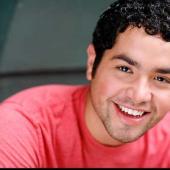Fringe blog (day 7): Immersion
Editorial

In light of Ira’s discussion of horror yesterday I began to think about my own emotions in theater. Am I ever truly experiencing what is happening onstage at the same level as the characters? Are there elements of theater that truly move me in surprising ways? For me, the distance of stage to audience creates a natural barrier to the action. This space allows me to disconnect from moments and retreat to me own private thoughts far away from the action. This holds me away from the action- becoming a witness in a passive seat in a dark anonymous room. So, I agree with Ira it is a challenge to pull off true horror within the artifice of an auditorium.
The action/audience distance is eliminated for me in video games which might be the reason why I jump, scream, and hold my breath while playing a horror game like Resident Evil—yet struggled against yawning during a production of Wait until Dark. I make the choices in Resident Evil and the consequence of running down the wrong hallway can lead me into a pack of starving zombies—which leads me to more decisions in the escape. I am fully engaged. I am alive in this story.
Could I ever feel the same way watching Resident Evil on stage? Even with a set designed by John Lee Beatty with special effects by the Walking Dead creators would I ever feel as immersed as I do when I’m playing PlayStation?
I witnessed an intersection of theater and video games at the Fringe Festival when I was able to both experience a play in the audience and play in a play as an omnipotent presence “onstage”.
The first piece I saw was THE TOURIST TRAP by Tim Uren at Theater in the Round. Set in The Bingham House in the Black Hills of South Dakota this was a delightful horror story with great performances by Charles Hubbell, Ariel Leaf, and Clarence Wethern. The Tourist Trap begins with a quiet visit to a seemingly unpopular museum dedicated to a serial killer that quickly dissolves into a torture den. There are moments of gore and horror, but they are buried in too much exposition. Sometimes I think not explaining the crazy in crazy people leaves the unexplained as the most intriguing aspect of a villain. In The Tourist Trap Tim Uren explains away the crazy, leaving a story with more holes than substance.
I was left wanting a more engaging story that would challenge me as a participant rather than a passive witness—fear has an in-your-face quality that this show lacked.
The next piece CRIME AND PUNISHMENT at the Soap Factory pushed the boundary of theatrical horror in a way needs to be experienced. Noah Bremer with Live Action Set has created a piece that echoes Sleep No More in New York, but retains its own depth and imagination. Like Sleep No More, audience members are asked to wear masks and remain silent for the duration of the performance. The mask design is taken from the Twilight Zone episode Eye of the Beholder, and immediately creates an environment of disorientation and menace. Once the masks are on, the audience is ushered into the basement to begin an hour of self-guided storytelling through endless rooms and alleys creating a Dostoevsky landscape of poverty and madness.
Unlike Sleep No More, where actors operate on a story track which allows different audience members to see the same scene, Crime and Punishment has no such tracks. A ghostly bell rings every fifteen minutes to signal the actors to move on to the next movement, but they never repeat the same story—Therefore each individual audience member experience is different from other audience members. Another change from Sleep No More is the added dialogue written for each character that allows them to talk to individuals and play scenes from the book. I found it fascinating to have a character engage me in a conversation while I remained silent while watching their growing desperation to connect to me.
Crime and Punishment is littered with hidden moments that might be witnessed by only one or two people. Characters are constantly pulling one or two audience members into closets, dark corners, and secret rooms to tell stories or explain certain events in their lives. I witnessed one truly horrifying monologue from Candace Barrett Birk in a closet which ended with a man breaking into our space with an axe, grabbing her and dragging her off while she screamed, “Help me! Please stop him!” Another friend was given ear buds and a tape recorder by someone who instructed him to a chair in a dark corner that had a flashlight and copy of the book Crime and Punishment underneath it. Then the tape recorder started to read the book verbatim. He opted out after four complete pages.
My experience with Crime and Punishment was a full body engagement. At first, I was lost in endless possibilities of rooms and locations. I needed to work through all the notions of being a good audience member—the passive energy of listening and observing, the comfortable distance between me and performer, the fifteen minute intermission, the second act gaze, and the endless curtain call. Soon, I calmed myself, thought back to the video games I love and began to explore the space on my own terms. Here in this basement I was not an audience member—I was in the story. I was being asked to participate, explore, push open doors, crawl through openings in walls, sit on furniture, hold a dying hand, witness a murder, dance in a burlesque show—I was asked to be alive.
I would love to be as invested in every play as much as I was in Crime and Punishment. There are certain theatrical conventions that make this difficult, but there are just as many possibilities to overcome these obstacles. The immediate tension created at the beginning of Pac-Man is the same tension Pinter hints at with the opening line, “As it is.” in No Man’s Land. The beauty that surrounds isolation in Myst can also be felt on a lonely road in Waiting for Godot. The uneasy disorienting air of Silent Hill is just as tangible in Susan Hill’s The Woman in Black.
I have always thought Hamlet would make a great video game. The story has all the elements of a multi-level adventure complete with bosses to kill at each level: Ghost in the prologue, Polonius battle to reach Ophelia, Rosencrantz and Guildenstern rapier fight with pirates on ship, and a final Laertes duel before reaching the King for the final battle. This version of Hamlet would place me in the middle of the action, making split second decisions that affect the outcome—hopefully with online capability in case my buddy wants to play the duel player mode as Horatio.
The difference in theater for me is that I observe choices without risk while with video games I risk losing as a result of my choices. Luckily the Fringe proved I can do both as an audience member—I hope the confines of an auditorium will not immediately prevent this in the future.




